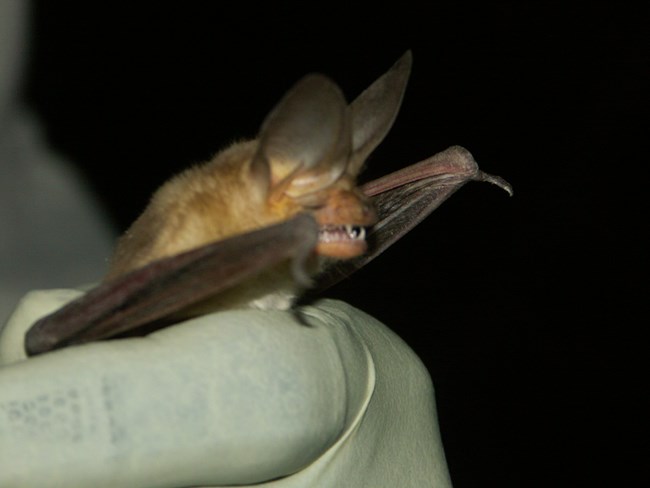
Round tail ground squirrels have developed large colonies in the park. The Nevada Department of Wildlife sums them up by saying "Extreme temperatures with low humidity normally characterize the round-tailed ground squirrel's habitat. The round-tailed ground squirrels prefer flat, sandy areas that are typified by creosote scrub vegetation. The Round-tailed ground squirrel is most active during mornings and evenings, avoiding the most intense heat by retiring to its burrow at midday or seeking shade under a plant. It will climb into bushes not only to obtain leaves, but also to get out of the sun and off the hot sand. This species hibernates from late September or early October to early January, though in some areas it remains active all year." 
Often we have bats in our belfry... that is, in our big house. Any bat that you can handle is likely sick, NEVER touch a bat or you may find yourself having to be treated for various diseases including possibly rabies. Bats do a wonderful job of eating insects and pollinating plants (including cacti), we do want them in our ecosystem. We would prefer, however, they pick another roost as they do some damage to the ruins unintentionally. Arizona Game and Fish mentions that "Arizona boasts an amazing diversity of bats: 28 species representing four families. Bats can be found all across our state in every type of Arizona habitat, from deserts to forests." TheUniversity of Arizona Cooperative Extension (PDF link) reminds us of some of our more unusual bats: "They feed on pollen and nectar and are critical to the pollination of columnar cacti such as the saguaro, organ pipe, and they also gather nectar from the agaves. Biologists calculate that the pollination of agaves and various cacti would drop approximately 97 percent without our nectivorous bats." 
Rabbits and Hares enjoy the park grounds. The owls in turn like them for dinner. The Arizona-Sonora Desert Museum shares plenty of information about rabbits such as "Of all the desert-dwelling mammals, the desert cottontail is probably the one you will see most frequently. Preyed upon by everything from snakes to coyotes to owls, most cottontails are killed within their first year. These rabbits have few defenses other than good eyesight, good hearing, and the ability to flee quickly. They compensate for heavy losses by reproducing at a prodigious rate. Female cottontails can breed at 3 months of age and have multiple litters in a year. Young stay at the nest for only about 2 weeks before venturing off. These reinforcements make for a fairly constant supply of cottontails. Jack "rabbits" -they are actually hares- live in open areas with little cover; they rely on exceptional speed and great leaping ability to evade predators, but they also suffer predative losses." 
Here a fox found a great hiding place, except that it is in a very public part of the park. |
Last updated: February 24, 2015
